What Is a Telephone Pole Transformer? A Simple Guide for Beginners?
Have you ever looked up at those gray cylinders on telephone poles and wondered what they do? These mysterious objects play a crucial role in powering our homes and businesses, yet many of us don’t know what they are.
A telephone pole transformer is a device that changes high-voltage electricity from power lines to a lower, safer voltage for use in homes and businesses. It’s a key part of the electrical grid, ensuring we have usable power in our buildings.
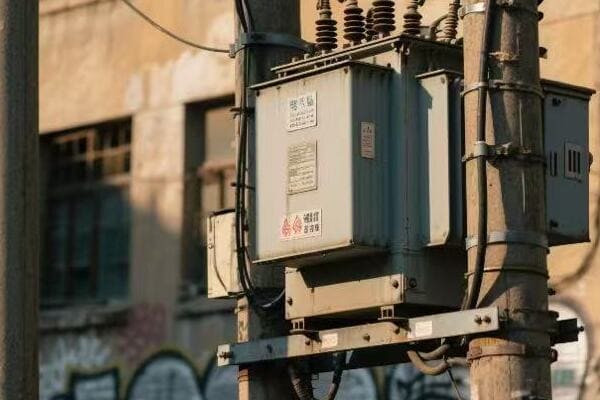
In this article, I’ll explain what these transformers do, how they work, and why they’re so important. Whether you’re a curious homeowner or someone interested in electrical systems, this guide will help you understand these vital components of our power infrastructure.
The Basics of Pole-Mounted Transformers: Function and Importance in Power Distribution?
Have you ever wondered why we need those bulky cylinders on telephone poles? They’re not just for show – these transformers are the unsung heroes of our power grid, working tirelessly to keep our lights on and our devices running.
Pole-mounted transformers are crucial in power distribution. They step down high voltage electricity from transmission lines to a lower, safer voltage for use in homes and businesses. These devices act as a bridge between the power grid and end-users, ensuring efficient and safe electricity delivery.
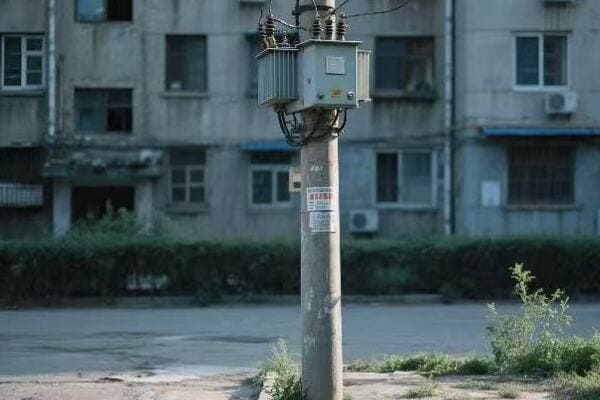
Understanding the Role of Pole-Mounted Transformers
To truly appreciate the importance of pole-mounted transformers, we need to break down their functions and significance:
1. Voltage Step-Down
The primary job of these transformers is to reduce the voltage of electricity. Power plants generate electricity at very high voltages, often between 155,000 to 765,000 volts. This high voltage is great for long-distance transmission but is far too dangerous for home use. Pole-mounted transformers step this voltage down to a usable level, typically 120/240 volts for homes in the United States.
2. Power Distribution
These transformers are key points in the distribution network. They take the electricity from main power lines and distribute it to individual buildings in a neighborhood. Without them, we’d need much more complex and expensive systems to get power from transmission lines to our homes.
3. Electrical Isolation
Transformers provide electrical isolation between the high-voltage system and consumer premises. This isolation is a crucial safety feature, protecting our homes from dangerous power surges and faults in the main grid.
4. Load Management
Transformers help manage the electrical load in different areas. Utility companies can adjust transformer settings to handle varying power demands in different neighborhoods or at different times of day.
Here’s a simple breakdown of the voltage transformation process:
| Stage | Voltage Level | Location |
|---|---|---|
| Generation | 155,000 – 765,000 V | Power Plant |
| Transmission | 155,000 – 765,000 V | Long-distance Power Lines |
| Sub-transmission | 69,000 – 138,000 V | Regional Distribution |
| Distribution | 4,000 – 34,500 V | Local Power Lines |
| End-User | 120/240 V | Homes and Businesses |
In my years working with electrical systems, I’ve seen firsthand how crucial these transformers are. I remember a project where we were upgrading the power supply for a growing suburban area. The existing transformers were overloaded, causing frequent power outages. By installing new, higher-capacity transformers, we were able to stabilize the power supply and accommodate the increased demand from new homes and businesses.
The importance of pole-mounted transformers goes beyond just delivering power. They’re a key part of making our electrical grid resilient and adaptable. As our energy needs change with the growth of electric vehicles and smart home technologies, these transformers will play an even more critical role in managing our power distribution.
Anatomy of a Telephone Pole Transformer: Key Components and How They Work?
Have you ever wondered what’s inside those mysterious cylinders on telephone poles? Let’s take a look at the inner workings of these essential devices that bring power to our homes and businesses.
A telephone pole transformer consists of several key components: a core made of laminated steel sheets, primary and secondary windings of insulated wire, insulating oil for cooling, and a protective tank. These parts work together to step down high voltage electricity to usable levels.
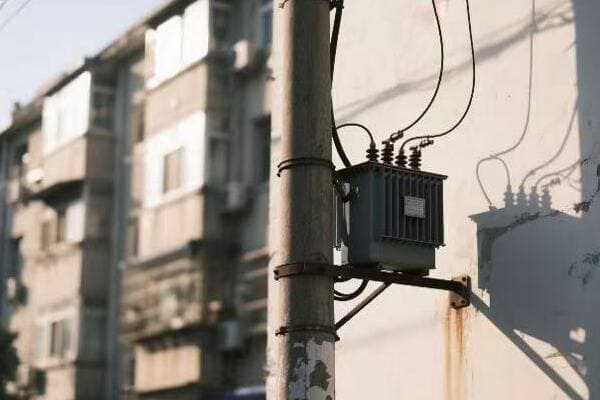
Breaking Down the Components of a Pole Transformer
Let’s dive deeper into the main parts of a pole transformer and how they function:
1. The Core
The core is the heart of the transformer. It’s made of thin, laminated sheets of silicon steel. These sheets are stacked together to form a rectangular or circular shape.
- Purpose: The core provides a path for the magnetic field that transfers energy between the primary and secondary windings.
- Why it matters: The laminated design reduces energy losses, making the transformer more efficient.
2. Windings
Transformers have two sets of windings: primary and secondary. These are coils of insulated copper or aluminum wire wrapped around the core.
- Primary Winding: Connected to the incoming high-voltage power lines.
- Secondary Winding: Delivers the stepped-down voltage to the distribution lines.
- How they work: The primary winding creates a magnetic field in the core, which then induces a voltage in the secondary winding.
3. Insulating Oil
The transformer tank is filled with a special type of oil.
- Purpose: The oil serves two main functions:
- Cooling: It absorbs heat from the core and windings.
- Insulation: It provides electrical insulation between components.
- Why it matters: Proper cooling and insulation are crucial for the transformer’s efficiency and lifespan.
4. Tank and Bushings
The tank houses all the internal components, while bushings are the connection points for the electrical wires.
- Tank: Usually made of steel, it protects the internal parts from the environment.
- Bushings: Insulated passages that allow electrical connections to enter and exit the tank safely.
Here’s a table summarizing the key components and their functions:
| Component | Function | Importance |
|---|---|---|
| Core | Provides path for magnetic flux | Enables energy transfer |
| Primary Winding | Receives high voltage | Input for transformation |
| Secondary Winding | Delivers low voltage | Output for consumer use |
| Insulating Oil | Cooling and insulation | Prevents overheating and breakdown |
| Tank | Protection | Shields internal components |
| Bushings | Electrical connections | Allows safe power transfer |
In my experience working with these transformers, I’ve always been amazed at how such a seemingly simple device can perform such a crucial function. I remember a time when we were troubleshooting a faulty transformer. By understanding each component’s role, we were able to pinpoint the issue to a problem with the insulating oil. It had degraded over time, reducing its cooling efficiency. Replacing the oil restored the transformer’s performance and prevented a potential failure.
The design of pole transformers is a testament to the ingenuity of electrical engineering. Each component plays a vital role in ensuring that we have safe, reliable power in our homes and businesses. As technology advances, we’re seeing innovations in materials and designs that make these transformers even more efficient and durable.
From High to Low: How Pole Transformers Step Down Voltage for Home Use?
Have you ever wondered how the incredibly high voltage in power lines becomes the safe, usable electricity in our homes? The answer lies in the fascinating process that occurs within pole transformers.
Pole transformers step down voltage through electromagnetic induction. The high voltage in the primary winding creates a magnetic field in the core, which then induces a lower voltage in the secondary winding. This process reduces the voltage from thousands to hundreds of volts for safe home use.
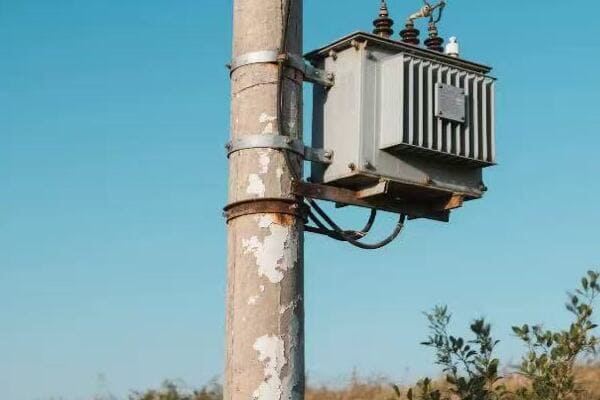
The Step-Down Process Explained
Let’s break down this complex process into simpler steps:
1. Input Stage
- High voltage electricity (typically 7,200 to 14,400 volts) enters the transformer.
- This electricity flows through the primary winding.
2. Magnetic Field Generation
- The current in the primary winding creates a changing magnetic field.
- This field is concentrated in the transformer’s steel core.
3. Induction
- The changing magnetic field induces a voltage in the secondary winding.
- The number of turns in the secondary winding is fewer than in the primary.
4. Voltage Reduction
- Due to the difference in winding turns, the voltage is reduced.
- Typically, it’s stepped down to 120/240 volts for residential use.
5. Output Stage
- The lower voltage electricity exits the transformer.
- It’s now safe for use in homes and businesses.
The relationship between the number of turns in the windings and the voltage is key to understanding how transformers work. Here’s a simplified formula:Vp / Vs = Np / Ns
Where:
- Vp = Primary voltage
- Vs = Secondary voltage
- Np = Number of turns in primary winding
- Ns = Number of turns in secondary winding
Let’s look at a practical example:
| Aspect | Primary Side | Secondary Side |
|---|---|---|
| Voltage | 7,200 V | 240 V |
| Number of Turns | 1,000 | 33 |
In this example, the primary winding has 1,000 turns and the secondary has 33 turns. This 30:1 ratio results in the voltage being stepped down from 7,200 V to 240 V.
I remember working on a project where we needed to upgrade the transformers in an older neighborhood. The existing transformers were struggling to handle the increased power demands from modern appliances and electric vehicles. By installing new transformers with optimized turn ratios, we were able to provide more stable voltage to the homes, reducing complaints about flickering lights and appliance issues.
The step-down process in pole transformers is a perfect example of how understanding and harnessing natural principles can lead to practical solutions. It’s amazing to think that this relatively simple concept of electromagnetic induction, discovered by Michael Faraday in 1831, is still the foundation of our modern power distribution system.
The efficiency of this process is crucial. While no transformer is 100% efficient, modern designs can achieve efficiencies of up to 98-99%. The small losses are mainly due to heat generated in the windings and core. That’s why proper cooling, usually through the insulating oil we discussed earlier, is so important.
As we move towards a future with more distributed energy resources, like solar panels and wind turbines, the role of transformers may evolve. We might see more bi-directional transformers that can handle power flowing both to and from homes. But the basic principle of stepping voltage up or down will remain a cornerstone of our electrical systems.
Types and Applications: Different Pole-Mounted Transformers in Electrical Systems?
When you look at telephone poles, you might think all those transformers look the same. But did you know there are actually different types, each designed for specific needs? Let’s explore the variety of pole-mounted transformers and their unique applications.
Pole-mounted transformers come in various types, including single-phase, three-phase, and autotransformers. Each type is designed for specific voltage requirements and applications, ranging from powering residential areas to supporting industrial operations and specialized electrical systems.
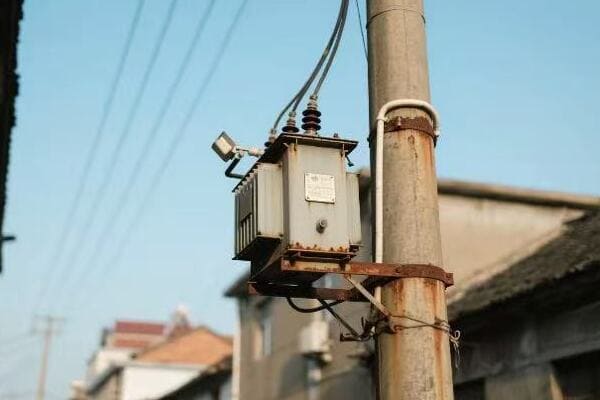
Exploring Transformer Types and Their Uses
Let’s dive into the main types of pole-mounted transformers and their applications:
1. Single-Phase Transformers
- Most common in residential areas
- Used for powering homes and small businesses
- Typically step down voltage from 7,200V to 120/240V
- Ideal for areas with lower power demands
2. Three-Phase Transformers
- Used in commercial and industrial settings
- Can handle higher loads and provide more efficient power distribution
- Often used in manufacturing plants, large office buildings, and shopping centers
- Step down voltage from higher levels (e.g., 12,470V) to usable levels (e.g., 480V)
3. Autotransformers
- Used for smaller voltage changes
- More efficient for certain applications
- Often used in power distribution systems for voltage regulation
- Can be used to boost voltage in long-distance power lines
4. Pad-Mounted Transformers
- Ground-level alternative to pole-mounted transformers
- Used in underground power distribution systems
- Common in newer residential developments and urban areas
- Offer improved aesthetics and protection from weather
Here’s a comparison table to help understand the differences:
| Type | Voltage Range | Main Applications | Advantages |
|---|---|---|---|
| Single-Phase | 7,200V to 120/240V | Residential areas | Simple, cost-effective |
| Three-Phase | 12,470V to 480V | Commercial, industrial | Higher efficiency, greater power capacity |
| Autotransformer | Various | Voltage regulation | Compact, economical for small voltage changes |
| Pad-Mounted | Similar to pole-mounted | Underground systems | Aesthetically pleasing, weather-protected |
In my experience, choosing the right type of transformer is crucial for efficient power distribution. I once worked on a project for a new industrial park where we needed to decide between multiple single-phase transformers or fewer three-phase units. We opted for three-phase transformers due to the high power demands of the manufacturing equipment. This choice not only provided more efficient power distribution but also saved space and reduced maintenance needs.
The choice of transformer type often depends on several factors:
- Load Requirements: The amount and type of power needed by the end-users.
- Existing Infrastructure: Whether the area already has single-phase or three-phase power lines.
- Future Growth: Anticipating increased power needs in the future.
- Environmental Factors: Considerations like weather conditions or aesthetic requirements.
For example, in a growing suburban area, we might start with single-phase transformers for residential use. But if there are plans for future commercial development, it might be wise to install three-phase transformers in certain locations to accommodate future needs.
Autotransformers, while less common in residential settings, play a crucial role in power transmission. I’ve seen them used effectively in substations to adjust voltage levels between different parts of the grid. Their efficiency in making small voltage adjustments makes them valuable for maintaining consistent voltage across long-distance power lines.
The trend towards underground power distribution in many urban and suburban areas has led to an increase in the use of pad-mounted transformers. These units offer the same functionality as pole-mounted transformers but with improved aesthetics and protection from the elements. In a recent project in a new residential development, we used pad-mounted transformers exclusively. The homeowners appreciated the unobstructed views, and the utility company found maintenance easier and safer.
As we move towards smarter, more flexible power grids, the role of transformers is evolving. We’re seeing the development of smart transformers that can communicate with the grid, adjust to changing loads, and even help integrate renewable energy sources. These advancements are making our power distribution systems more efficient and resilient.
Safety and Maintenance: Caring for Telephone Pole Transformers in Your Neighborhood?
Have you ever wondered about the safety of those transformers hanging on poles in your neighborhood? Or maybe you’re curious about how they’re maintained? Let’s explore the important aspects of safety and maintenance for these crucial devices.
Safety around pole transformers involves respecting clearances, reporting issues, and avoiding contact. Maintenance includes regular inspections, oil testing, and repairs by trained professionals. Proper care ensures reliable power distribution and prevents hazards in your neighborhood.
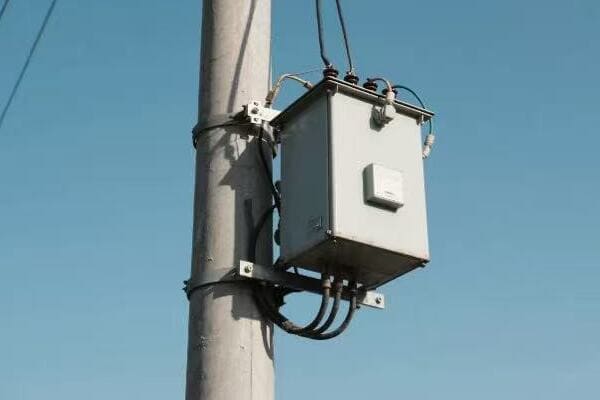
Safety First: Protecting Your Community
When it comes to pole transformers, safety is paramount. Here are key safety considerations:
1. Clearance Zones
- Keep a safe distance from transformers
- Never climb poles or tamper with equipment
- Maintain required clearances when planting trees or building structures
2. Reporting Issues
- Contact your utility company if you notice:
- Unusual noises
- Oil leaks
- Physical damage to the transformer
- Don’t attempt to fix issues yourself
3. Emergency Situations
- In case of fire or severe damage, call emergency services immediately
- Keep others away from the area
Maintenance: Keeping the Power Flowing
Regular maintenance is crucial for the longevity and efficiency of pole transformers. Here’s what typically happens:
1. Routine Inspections
- Visual checks for damage or wear
- Thermal imaging to detect hot spots
- Check for oil leaks or corrosion
2. Oil Testing and Replacement
- Regular sampling and testing of transformer oil
- Oil replacement if contaminated or degraded
3. Load Management
- Monitoring transformer load to prevent overheating
- Adjusting connections if needed
4. Repairs and Replacements
- Addressing issues promptly to prevent failures
- Replacing old or damaged transformers
Here’s a table summarizing key maintenance tasks and their frequency:
| Maintenance Task | Frequency | Importance |
|---|---|---|
| Visual Inspection | Monthly | Detect visible issues early |
| Oil Testing | Annually | Ensure proper insulation and cooling |
| Thermal Imaging | Quarterly | Identify potential overheating |
| Load Assessment | Ongoing | Prevent overloading and extend lifespan |
In my years of experience with electrical systems, I’ve seen how proper maintenance can prevent major issues. I remember a case where routine oil testing revealed contamination in a transformer. By addressing this early, we avoided a potential failure that could have left an entire neighborhood without power for days.
For homeowners and community members, the best way to contribute to transformer safety and maintenance is to be observant and report any concerns to your utility company. Your awareness can help prevent accidents and ensure a reliable power supply for everyone.
The Impact of Weather on Transformer Maintenance
Weather plays a significant role in transformer maintenance. Different climates present unique challenges:
Hot Climates
- Increased risk of overheating
- More frequent oil checks and cooling system inspections
- Possible need for additional cooling measures
Cold Climates
- Risk of oil freezing in extreme cold
- Checks for ice buildup on external components
- Ensuring proper insulation against temperature fluctuations
Coastal Areas
- Higher risk of corrosion due to salt air
- More frequent checks for rust and deterioration
- Special coatings may be needed for protection
Storm-Prone Regions
- Regular checks for damage from high winds or lightning
- Ensuring proper grounding and surge protection
- Possible need for reinforced mounting or additional guy wires
I once worked in a coastal area where the salt air was causing rapid corrosion of transformer components. We implemented a program of more frequent inspections and started using specially coated hardware. This proactive approach significantly extended the life of the transformers and reduced unexpected outages.
The Role of Technology in Transformer Maintenance
Advancements in technology are changing how we maintain transformers:
-
Smart Sensors: These can continuously monitor transformer health, alerting maintenance teams to potential issues before they become serious problems.
-
Drones: Used for visual inspections of hard-to-reach transformers, reducing the need for workers to climb poles.
-
AI and Machine Learning: These technologies can analyze data from transformers to predict when maintenance will be needed, allowing for more efficient scheduling of repairs.
-
Mobile Apps: Utility workers can now access transformer data and maintenance history in real-time, improving the speed and accuracy of their work.
In a recent project, we implemented a system of smart sensors on a group of transformers in a rural area. The real-time data allowed us to detect and address issues much faster than our previous schedule of periodic manual inspections. This not only improved reliability but also reduced maintenance costs over time.
Community Involvement in Transformer Safety
While maintenance is primarily the responsibility of utility companies, community involvement can play a crucial role in transformer safety:
-
Education: Understanding the basics of transformer safety can help residents avoid risks and recognize potential problems.
-
Reporting: Encouraging community members to report any unusual sights or sounds near transformers can lead to early detection of issues.
-
Landscaping: Proper tree trimming and landscaping around transformers can prevent interference and make maintenance easier.
-
Emergency Preparedness: Communities can develop plans for extended power outages in case of transformer failures.
I’ve seen the positive impact of community involvement firsthand. In one neighborhood, after we conducted a safety awareness campaign, reports of potential transformer issues increased significantly. This led to several preventive maintenance actions that likely avoided future outages.
Looking to the Future of Transformer Maintenance
As our power grids evolve, so too will our approach to transformer maintenance:
-
Predictive Maintenance: Moving from scheduled maintenance to predictive maintenance based on real-time data.
-
Eco-Friendly Materials: Development of more environmentally friendly insulating oils and materials.
-
Integration with Smart Grids: Transformers becoming active, communicative parts of smart grid systems.
-
Remote Diagnostics: Increased ability to diagnose and even solve some issues remotely, reducing the need for field visits.
The field of transformer maintenance is constantly evolving, and staying updated with these changes is crucial for ensuring the reliability and safety of our power distribution systems.
Conclusion
Telephone pole transformers are vital components of our power distribution system. They step down high voltage to safe levels for home use, come in various types for different applications, and require regular maintenance for safe, efficient operation. Understanding these devices helps us appreciate the complexity of our power infrastructure.
Free CHBEB Transformer Catalog Download
Get the full range of CHBEB transformers in one catalog.
Includes oil-immersed, dry-type, pad-mounted, and custom solutions.
Quick Message
Request A free quote
We'd like to work with you
- +86 15558785111
- [email protected]
- +86 15558785111
What We Do
CHINA BEI ER BIAN (CHBEB) GROUP, with 218 million in registered capital, originated from Beijing Beierbian Transformer Group. Headquartered in Beijing for R&D, it operates major production bases in Nanjing and Yueqing, producing high-quality products.
Latest Product
address
BeiJing
No 3,RongJing East Road,BeiJing Economic Technological Development Area,BeiJing,China
JiangSu
No 7️Xiangfeng Road,Jiangning,NanJing,JiangSu,China
WenZhou
No.211, Wei 16 Road, Industrial Zone, Yueqing, Wenzhou, Zhejiang, China.
XiangYang Industrial Zone ,YueQing,WenZhou,ZheJiang,China
contact us
- [email protected]
- +86 13057780111
- +86 13057780111
- +86 15558785111
Copyright © Bei Er Bian Group


